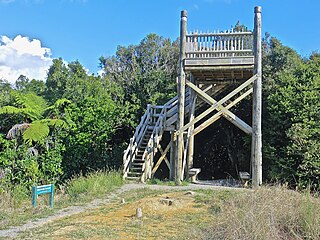
Hakarimata Range is a range of hills on the western edge of Ngāruawāhia township, in the Waikato region of New Zealand, overlooking the confluence of the Waikato and Waipa Rivers. The Hakarimata Range is separated from the Taupiri Range by the Taupiri Gorge, through which the Waikato River flows.
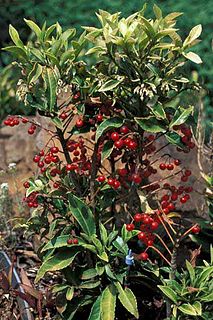
Myrsinoideae is a subfamily of the family Primulaceae in the order Ericales. It was formerly recognized as the family Myrsinaceae, or the myrsine family, consisting of 35 genera and about 1000 species. It is widespread in temperate to tropical climates extending north to Europe, Siberia, Japan, Mexico, and Florida, and south to New Zealand, South America, and South Africa.

Urtica ferox, commonly known as tree nettle and in Māori: ongaonga, taraonga, taraongaonga, оr okaoka, is a species of nettle endemic to New Zealand. Unlike the other species in the genus Urtica found in New Zealand, all of which are herbaceous, ongaonga is a large woody shrub that can grow to a height of 3 m (9.8 ft), with the base of the stem reaching 12 cm (4.7 in) in thickness. It has large spines that can result in a painful sting that lasts several days.

Olearia, most commonly known as daisy-bush, is a genus of flowering plants belonging to the family Asteraceae, the largest of the flowering plant families in the world. Olearia are found in Australia, New Guinea and New Zealand. The genus includes herbaceous plants, shrubs and small trees. The latter are unusual among the Asteraceae and are called tree daisies in New Zealand. All bear the familiar daisy-like composite flowerheads in white, pink, mauve or purple.

Dracophyllum is a genus of plants belonging to the family Ericaceae, formerly Epacridaceae. There are 61 species in the genus, mostly shrubs, but also cushion plants and trees, found in New Zealand, Australia, Lord Howe Island and New Caledonia. The name Dracophyllum, meaning dragon-leaf, refers to their strong outward similarity to the unrelated Dracaena, sometimes known as dragon tree. Although dicotyledonous, they resemble primitive monocots with their slender leaves concentrated in clumps at the ends of the branches; they are sometimes called grass-trees.

Corokia is a genus in the Argophyllaceae family. The genus was first described in 1839. It comprising six species native to New Zealand, Australia and Rapa Iti. Corokia species are shrubs or small trees with zigzagging (divaricating) branches. In fact, Corokia cotoneaster is commonly known as wire-netting bush. The stems of the shrubs are dark when mature, covered with downy or silky hairs (tomentum) when young. In spring, they produce clusters of small, star-shaped yellow blossoms. Berries are red or yellow. The shrubs prefer forests and rocky areas, sun or light shade, reasonably well drained soil, and moderate watering.
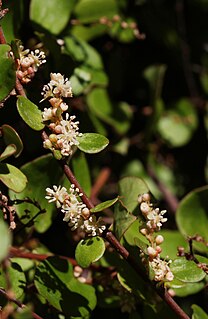
Muehlenbeckia complexa, commonly known as pohuehue, although this name also applies to some other climbers such as Muehlenbeckia australis.
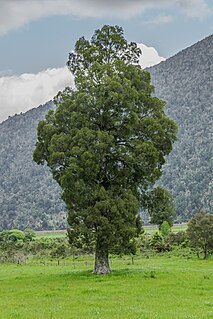
Libocedrus bidwillii, also called pāhautea, kaikawaka or New Zealand cedar, is a species of Libocedrus, endemic to New Zealand. It is in the cypress family Cupressaceae.

Rapanea is a genus of plant in family Primulaceae. It has often been placed in synonymy with Myrsine, and many species have been moved to Myrsine. As of April 2022, Plants of the World Online does not accept the genus, regarding it as a synonym of Myrsine.

Myrsine is a genus of flowering plants in the family Primulaceae. It was formerly placed in the family Myrsinaceae before this was merged into the Primulaceae. It is found nearly worldwide, primarily in tropical and subtropical areas. It contains about 200 species, including several notable radiations, such as the matipo of New Zealand and the kōlea of Hawaiʻi. In the United States, members of this genus are known as colicwood. Some species, especially M. africana, are grown as ornamental shrubs.

Leucopogon fasciculatus, the tall mingimingi, is a species of shrub within the family Ericaceae. It is endemic to New Zealand. This species is found in the North Island north of the Bay of Plenty and Taranaki. In the South Island it is found in north west Nelson. It is present in the red and silver beech forests admixed with rimu and miro podocarps on northern South Island.

Myrsine australis, commonly known as māpou, red matipo, māpau, tīpau, and mataira, is a species of shrub within the family Myrsinaceae. It is endemic to New Zealand, found throughout both the mainland and offshore islands.

Olearia phlogopappa commonly known as the dusty daisy-bush or alpine daisy-bush is a species of flowering plant in the family Asteraceae that is commonly found in eastern New South Wales, Victoria and Tasmania. It is a small shrub with greyish-green foliage, daisy-like flowers in white, pink or mauve that can be seen from spring to late summer.
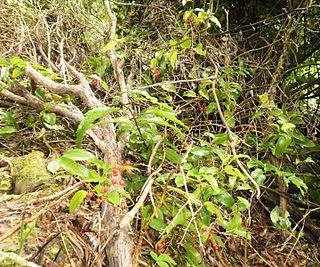
Ripogonum scandens, is a common rainforest vine native to New Zealand. It can also grow in areas of swamp.
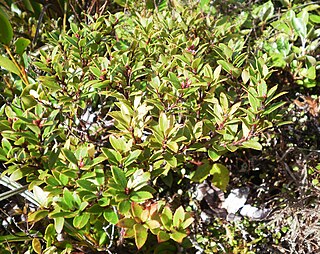
Gaultheria rupestris is a shrub in the family Ericaceae. This species is endemic to New Zealand.

Dracophyllum longifolium, commonly called inaka, is an upright shrub or small tree in the family Ericaceae that is endemic to New Zealand.

Gaultheria oppositifolia is a shrub in the heath family Ericaceae, endemic to New Zealand. Māori names include kama and niniwa. Common name for the genus in New Zealand is snowberry.

Corokia cotoneaster is a flowering plant in the family Argophyllaceae. Which was described by Étienne Fiacre Louis Raoul in 1846. This plant is commonly known as the wire-netting bush, korokio, or korokia-tarango. The word "Koriko" comes from the Māori language.

Acrothamnus colensoi is a plant species from the family Ericaceae and is endemic to New Zealand.



















